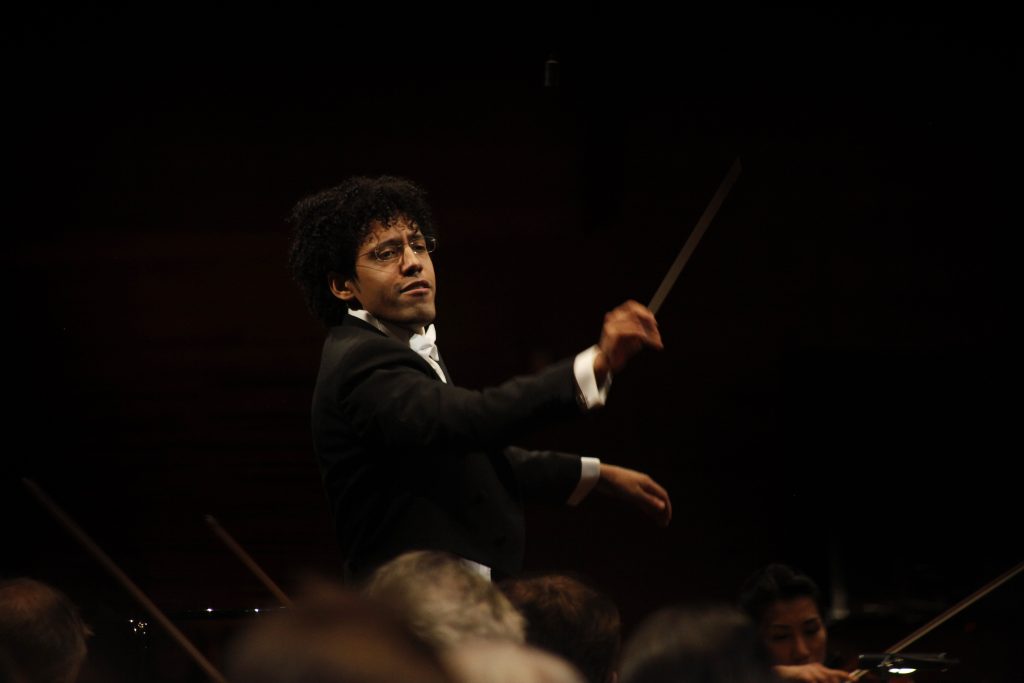New San Diego Symphony Music Director Rafael Payare Thrills with Mahler’s Fifth Symphony
Rafael Payere thrilled the sold-out audience at Copley Symphony Hall Saturday leading the San Diego Symphony in an electric, emotionally riveting account of Gustav Mahler’s monumental Fifth Symphony. Conducting this long—at times sprawling—70-minute symphony from memory, Payare proved that he knew exactly what he wanted in every measure of Mahler’s rewarding, complex score, and the orchestra eagerly did his bidding.

Rafael Payare [photo (c.) Bjorne Bertheussen]
As the symphony’s C.E.O. Martha Gilmer noted in Saturday’s opening welcome, it has been a long wait for Payare’s ascension to the Music Director position. But this opening concert proved the wait was worth it.
From the Fifth Symphony’s portentous opening trumpet call, magnificently executed by Principal Trumpet Christopher Smith, the stage was set for a nonpareil performance, and we were not disappointed. Payere adroitly navigated the many chiaroscuro changes of the first movement, a deftly orchestrated funeral march, coaxing somber sighs from the strings at one moment, mellow woodwind progressions the next, then unleashing the ecstatic fury of the full orchestra.
Principal Horn Benjamin Jaber and his sonically unified section happily dominated much of the Scherzo, Mahler’s brilliantly calibrated orchestral melee placed at the apex of his five-movement symphony. Payare kept his kaleidoscopic changes of texture in sharp focus, and his lithe pulse found that agreeable center point for which Mahler asks in the movement’s subtitle, “Vigorously, not too fast.” Kudos to Concertmaster Jeff Thayer for his lightly sardonic solo account of the country dance the orchestra is allowed to develop with such relish.
Although Payare skillfully shaped the much loved Adagietto, the delectable movement of the Fifth Symphony that won early approval even when the work as a whole was neglected in those years following Mahler’s death, on Saturday this movement remained rather earthbound. Creating a deep, lustrous string section sonority remains a challenge for the new Music Director.
In the final movement, the strings made a respectable bid for redemption subduing its vibrant fugue at breakneck speed. Payare rightly found Mahler’s existential urgency beneath the movement’s ebullient energy, and the nobility of the stirring brass chorale at its conclusion aptly crowned both the Fifth Symphony and the new Music Director’s debut.
The orchestral works of Mason Bates, the 42-year-old American composer who holds the position of Composer-in-Residence at Washington D.C.’s Kennedy Center, have been widely programmed by American orchestras, and Santa Fe Opera premiered first opera, The (R)evolution of Steve Jobs, in 2017. Just a year ago, San Diego Symphony’s Principal Guest Conductor Edo de Waart conducted the orchestra in Bates’ 2014 “Garages of the Valley.”
Bates’ Alternative Energy, written for the Chicago Symphony in 2011 while he was their Composer-in-Residence, owes a modest debt to the flashy, descriptive tone poems of Richard Strauss and Edgard Varèse’s reliance on large percussion sections, electronic components, sirens and other “non-orchestral” implements. Each movement of Alternative Energy depicts a moment in history or the future that reflects the state of energy production.
“Ford’s Farm, 1896,” Bates’ opening movement, bristles with metallic bangs, rattles, and a very large ratchet from the percussion section. Concertmaster Thayer nimbly offered the work’s jaunty, slightly jazzy main theme that would eventually sneak into each other movement when least expected. Bates’ movement title alludes to Henry Ford’s search for metal components for his first automobile.
“Chicago, 2012” sustains the sound of a gently gurgling cauldron marked by spurts of recorded sound samples taken from a high tech particle accelerator at the Fermilab research center, located in a suburb of Chicago, Illinois. My science knowledge is too feeble to know just how high-energy particle physics is changing our contemporary energy production, but I am willing to take it on faith that Bates’ musical movement gives us a sonic picture of current energy research. I believe this is the first time the San Diego Symphony has used a computer as an active participant in the orchestral tapestry. Percussionist Jon Szanto supplied his expertise to this end.
“Xinjiang Province, 2112” opens with austere, sustained washes of sound that the composer intends to depict what will then remain 100 years from now of that remote province where much of China’s energy industry is now located. Onto this sonic wasteland Bates tosses a wild, manic flute solo, boldly supplied by Principal Flute Rose Lombardo and gracefully extended by oboist Andrea Overturf and the full orchestra. Soon the full percussion section, propelled by bravura mallet players, takes over and ends the movement with breathtaking flourishes.
In “Reykjavik, 2222” Bates imagines a meltdown of the planet has turned the Icelandic capital into a tropical rain forest, and he supplies natural sounds you would experience in a movie soundtrack for such a tropical setting. Short motifs echo back and forth between the marimba and the strings, with the main theme from the first movement returning to unify his imaginative tone poem.
I cannot recall when a substantial work of contemporary music has ever occupied half of a San Diego Symphony season-opening concert. Allow me to cast my vote in favor of this refreshing programming.
This concert was presented by the San Diego Symphony on Saturday, October 5, 2019, in the Jacobs Music Center’s Copley Symphony Hall in downtown San Diego. It was repeated on October 6 in the same venue.

Ken Herman, a classically trained pianist and organist, has covered music for the San Diego Union, the Los Angeles Times’ San Diego Edition, and for sandiego.com. He has won numerous awards, including first place for Live Performance and Opera Reviews in the 2017, the 2018, and the 2019 Excellence in Journalism Awards competition held by the San Diego Press Club. A Chicago native, he came to San Diego to pursue a graduate degree and stayed.Read more…
